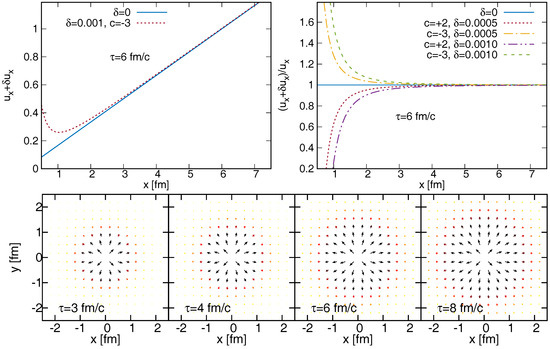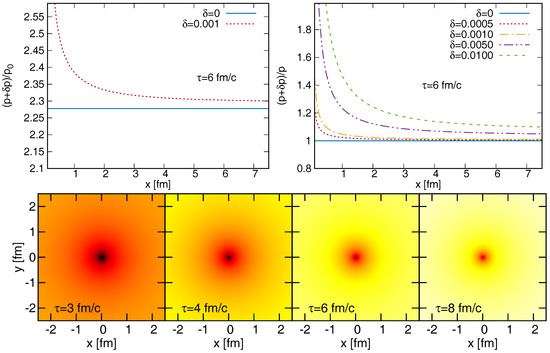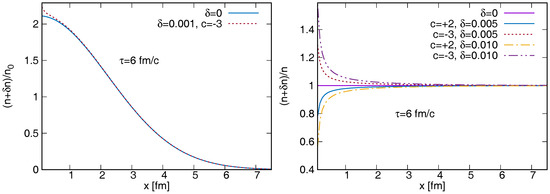Abstract
In ultra-relativistic collisions of heavy ions, the strongly interacting Quark Gluon Plasma (sQGP) is created. The fluid nature of the sQGP was one of the important discoveries of high energy heavy ion physics in the last decades. Henceforth the explosion of this matter may be described by hydrodynamical models. Besides numerical simulations, it is important to study the analytic solutions of the equations of hydrodynamics, as these enable us to understand the connection of the final and initial states better. In this paper we present a perturbative, accelerating solution of relativistic hydrodynamics, on top of a known class of solutions describing Hubble-expansion. We describe the properties of this class of perturbative solutions, and investigate a few selected solutions in detail.
1. Introduction
The equations of perfect hydrodynamics have no internal scale, and hence they describe aspects of the time evolution of systems with vastly different sizes: from galactic clusters and galaxies through stars, planets and human-scale systems, down to the femtometer scale sQGP, created in heavy ion collisions at RHIC [1,2] and the LHC [3,4,5,6]. The sQGP is formed in heavy ion collisions after an initial thermalization time , its evolutions lasts , after that it creates hadrons in the hadronization. We observe these hadrons, and hydrodynamics may be used to infer the time evolution and the initial state from the hadron final state distributions.
Hydrodynamics is based on the local conservation of energy and momentum, expressed through
with being the energy-momentum tensor. In case of a perfect fluid, this can be written as
where is the flow field (subject to the constraint), is the energy density, p is the pressure and is the metric tensor, . The Equation of State (EoS) closes this set of equations:
where is the EoS parameter, which may depend on the temperature. In this paper we assume constant values, even if type of solutions of relativistic hydrodynamics are know [7]. In case of the above described perfect fluid, continuity for the entropy density follows from the above equations, and a similar continuity equation for the density of some conserved charge (n) may be prescribed:
With this, a solution of the equations is a set of fields or , given in terms of coordinates , where sometimes also the coordinate proper-time is introduced as , along some scaling variable that describes the spatial profile of the densities in the solution.
The discovery of the fluid nature of the sQGP produced a revival of interest for solutions of hydrodynamics, beyond the well-known Landau-Khalatnikov [8,9] and Hwa-Bjorken [10,11] solutions. Besides numerical simulations (see e.g. Refs. [12,13,14] for recent examples), multiple advanced analytic solutions were found in the last decade [7,15,16,17,18,19,20,21]. One important example is the simple, ellipsoidal Hubble-flow described in Ref. [15], which describes hadron and photon observables well [22,23]. However, this solution lacks acceleration, and while Hubble-flow is natural in the final state, initial pressure gradients may be important in understanding the time evolution of this system. In this paper we attempt to find accelerating perturbations on top of Hubble-flow.
2. Perturbative Solutions of Hydrodynamics
The equation for the conservation of energy and momentum density, Equation (1) may be projected onto , producing a Lorentz-parallel and a Lorentz-orthogonal equation, similarly to Refs. [7,17]:
where the first is called the energy equation, and the second is the Euler equation of relativistic hydrodynamics. If a given solution is given in terms of , then perturbations on top of this solution may be given as:
where we restrict ourselves to a conserved charge here, but the continuity may be understood for the entropy density just as well. Now if these perturbations are small, then the equations of hydrodynamics may be given in first order. First of all, the perturbations of the flow field must fulfill
which yields the first order equation of
With this, we may substitute the perturbed fields in Equations (8)–(10) into the equations of hydrodynamics, Equations (5)–(7). For the continuity equation, we get the following first order equation:
For the energy equation, we obtain:
And for the Euler-equation, the first order perturbative equation is
To perform a basic consistency check of the above equations, one may investigate what happens when the basic solution of a fluid at rest. The flow and pressure is then
One may immediately observe, that , , and . With this, the linearized energy and Euler equations become
The time derivative of the energy equation is then
Let us then introduce the operator — which is here nothing else than . Then the effect of on the Euler equation is
where we observed that
3. Perturbations on Top of Hubble-Flow
As mentioned above, in Ref. [15] a Hubble-type of self-similar solution is given, with a flow field
where again is the coordinate proper-time. The basic quantity of this solution is the scale variable assuring self-similarity, for which the comoving derivative vanishes:
Since in this case, , the following simple pressure field and density can be obtained:
where is an arbitrary scale function. This solution can be generalized to describe multipole type of scale variables [21], but a standard choice yielding ellipsoidal symmetry is
with the coordinates given as , and the axes of the expanding ellipsoid are , all linear in time. We will focus here on the spherical case:
where r is the radial coordinate, and describes the expansion velocity of the scale of the solution. This solution yields the following equations for the perturbations of the fields:
A similar setup was investigated in Ref. [24], where the authors found expressions for the ripples propagating on Hubble-flow. Unlike Ref. [24], we will now discuss global perturbations in terms of , and .
In this proceedings paper we do not detail the way this solution was obtained, but simply present the result for the flow, pressure and density:
where S is the scale variable (with vanishing comoving derivative), is the perturbation scale, c is an arbitrary constant, are profile functions, while , , are scale functions subject to the following condition equations:
In simple terms, these equations can be translated to the following conditions:
- The scale variable S fulfills with the original flow field.
First of all, let us restrict ourselves to the simplest case of here, in order to describe the way this class of perturbative solutions works. This gives a simple form for F as
Then let us select an h function that leads to simpler condition equations:
While more general solutions can also be found, a broad class of perturbative solutions can already be given, if suitable S scale variables and associated , , and h functions are found. Such suitable scale variables include
In the next section, we will detail one particular sub-class of this class of solutions.
4. A Selected Sub-Class of Perturbative Solutions
If we introduce h as given in Equations (39)–(40) and S as , we obtain the following scale functions:
This sub-class of solutions contains an arbitrary parameter c, the perturbation scale, the m exponent and the scale function (included in the original Hubble-solution as well). Let us chose , then the scale functions are
Let us furthermore choose a suitable , leading to a Gaussian profile:
With these, the perturbed fields (for , the special case of is discussed in Equation (40)) are as follows:
For the visualisation of these fields, let us chose parameter values from Refs. [22,23] as , and .
On the top left panel of Figure 1, a slice of the x component of the flow field is shown with fm/c, and . The perturbation is the most important in the center, it also changes the direction of the field, but it vanishes for large radial distances. The top right panel indicates the c and dependence of the relative perturbed fields. We observe here that for this particular solution, the relative perturbation increases to very large values for very small distances. The bottom panel of Figure 1 indicates the transverse flow field for various proper-time slices, showing that also the direction of the flow is perturbed for some particular distances. Next, let us investigate the pressure perturbation. The top panels of Figure 2 shows the pressure field with fixed values of and fm/c (there is no c-dependence in p). Again it is clear that the perturbation vanishes for increasing radial distance, and increases for small distances. It is an important next step to present a sub-class of perturbative solutions that does not exhibit this feature. One may also note that controls the perturbation magnitude, as also visible in the ratio plots in the top right panel of Figure 2. On the bottom panel, the time evolution of the pressure perturbation is given in the transverse plane, showing a vanishing perturbation for large times. Finally, let us investigate the behavior of the density n. The left panel of Figure 3 (with fm/c, and ) indicates again a vanishing perturbation for large distances. The right panel shows the relative perturbation and its dependence on and c. As it can be seen also in the figures, the perturbations become larger than the original fields for very small radial distances and large values, i.e. the method breaks down in these cases. This sets a limit to the applicability of the particular investigated perturbative solutions. Note however, that this is not necessarily a general property of the whole class of solutions.

Figure 1.
The perturbed flow field component () is shown in the left plot as a function of x, for fm/c (the other parameters are given in the text). The right plot indicates the relative change for various and c values. The bottom plot shows the flow perturbation field in the transverse plane, for various proper-time values.

Figure 2.
The perturbed pressure is shown in the left plot as a function of x, for fm/c (the other parameters are given in the text). The right plot indicates the relative change for various and c values. The bottom plot shows the pressure perturbation in the transverse plane, for various proper-time values.

Figure 3.
The perturbed density is shown in the left plot as a function of x, for fm/c (the other parameters are given in the text). The right plot indicates the relative change for various and c values.
With these fields at hand, and utilizing a freeze-out hypersurface similarly to e.g., Ref. [22], one may evaluate observables such as transverse momentum distribution, flow and Bose-Einstein correlation radii. We plan to do this in a subsequent publication.
5. Conclusions
In this paper we presented the method of obtaining perturbative solutions of relativistic hydrodynamics on top of known solutions. A new perturbative class of solutions on top of Hubble flow was discussed, and the modified fields were investigated in detail. These fields were scaled to a single perturbation parameter, and several scale functions appeared, subject to condition equations. As a subsequent step, we plan to describe more particular sub-classes of solutions. We also plan to calculate the modification of observables and in case of realistic geometries, we plan to compare them to measurements.
Acknowledgments
The authors are supported by the New National Excellence program of the Hungarian Ministry of Human Capacities and the NKFIH grant FK-123842. M. Cs. was also supported by the János Bolyai Research Scholarship of the Hungarian Academy of Sciences.
Author Contributions
B.K. performed a large part of the calculations and visualisations, under supervision of M.C., who in turn wrote most of the actual text of this paper.
Conflicts of Interest
The authors declare no conflict of interest.
References
- Adcox, K.; Adler, S.S.; Afanasiev, S.; Aidala, C.; Ajitanand, N.N.; Akiba, Y.; Al-Jamel, A.; Alexander, J.; Amirikas, R.; Aoki, K.; et al. Formation of dense partonic matter in relativistic nucleus nucleus collisions at RHIC: Experimental evaluation by the PHENIX collaboration. Nucl. Phys. 2005, 757, 184–283. [Google Scholar] [CrossRef]
- Adams, J.; Aggarwal, M.M.; Ahammed, Z.; Amonett, J.; Anderson, B.D.; Arkhipkin, D.; Averichev, G.S.; Badyal, S.K.; Bai, Y.; Balewski, J.; et al. Experimental and theoretical challenges in the search for the quark gluon plasma: The STAR collaboration’s critical assessment of the evidence from RHIC collisions. Nucl. Phys. 2005, 757, 102–183. [Google Scholar] [CrossRef]
- Aamodt, K.; Abrahantes Quintana, A.; Adamová, D.; Adare, A.M.; Aggarwal, M.M.; Aglieri Rinella, G.; Agocs, A.G.; Aguilar Salazar, S.; Ahammed, Z.; Ahmad, N.; et al. Suppression of Charged Particle Production at Large Transverse Momentum in Central Pb–Pb Collisions at = 2.76 TeV. Phys. Lett. 2011, 696, 30–39. [Google Scholar] [CrossRef]
- Aamodt, K.; Abelev, B.; Abrahantes Quintana, A.; Adamová, D.; Adare, A.M.; Aggarwal, M.M.; Aglieri Rinella, G.; Agocs, A.G.; Aguilar Salazar, S.; Ahammed, Z.; et al. Elliptic flow of charged particles in Pb-Pb collisions at 2.76 TeV. Phys. Rev. Lett. 2010, 105, 252302. [Google Scholar] [CrossRef] [PubMed]
- Chatrchyan, S.; Khachatryan, V.; Sirunyan, A.M.; Tumasyan, A.; Adam, W.; Bergauer, T.; Dragicevic, M.; Erö, J.; Fabjan, C.; Friedl, M.; et al. Study of high-pT charged particle suppression in PbPb compared to pp collisions at = 2.76 TeV. Eur. Phys. J. C 2012, 72, 1945. [Google Scholar] [CrossRef]
- Chatrchyan, S.; Khachatryan, V.; Sirunyan, A.M.; Tumasyan, A.; Adam, W.; Bergauer, T.; Dragicevic, M.; Erö, J.; Fabjan, C.; Friedl, M.; et al. Measurement of the elliptic anisotropy of charged particles produced in PbPb collisions at nucleon-nucleon center-of-mass energy = 2.76 TeV. Phys. Rev. 2013, 87, 014902. [Google Scholar]
- Csanád, M.; Nagy, M.; Lökös, S. Exact solutions of relativistic perfect fluid hydrodynamics for a QCD equation of state. Eur. Phys. J. A 2012, 48, 173. [Google Scholar] [CrossRef]
- Landau, L.D. On the multiparticle production in high-energy collisions. Izv. Akad. Nauk SSSR Ser. Fiz. 1953, 17, 51–64. [Google Scholar]
- Khalatnikov, I.M. Some problems of relativistic hydrodynamics. Zh. Eksp. Teor. Fiz. 1954, 27, 529. [Google Scholar]
- Hwa, R.C. Statistical Description of Hadron Constituents as a Basis for the Fluid Model of High-Energy Collisions. Phys. Rev. D 1974, 10, 2260. [Google Scholar] [CrossRef]
- Bjorken, J.D. Highly Relativistic Nucleus-Nucleus Collisions: The Central Rapidity Region. Phys. Rev. D 1983, 27, 140–151. [Google Scholar] [CrossRef]
- Shen, C.; Qiu, Z.; Song, H.; Bernhard, J.; Bass, S.; Heinz, U. The iEBE-VISHNU code package for relativistic heavy-ion collisions. Comput. Phys. Commun. 2016, 199, 61–85. [Google Scholar] [CrossRef]
- Pang, L.G.; Petersen, H.; Wang, Q.; Wang, X.N. Vortical Fluid and Λ Spin Correlations in High-Energy Heavy-Ion Collisions. Phys. Rev. Lett. 2016, 117, 192301. [Google Scholar] [CrossRef] [PubMed]
- Weller, R.D.; Romatschke, P. One fluid to rule them all: Viscous hydrodynamic description of event-by-event central p+p, p+Pb and Pb+Pb collisions at = 5.02 TeV. Phys. Lett. B 2017, 774, 351–356. [Google Scholar] [CrossRef]
- Csörgo, T.; Csernai, L.P.; Hama, Y.; Kodama, T. Simple solutions of relativistic hydrodynamics for systems with ellipsoidal symmetry. Heavy Ion Phys. A 2004, 21, 73–84. [Google Scholar] [CrossRef]
- Csörgo, T.; Nagy, M.I.; Csanád, M. A new family of simple solutions of perfect fluid hydrodynamics. Phys. Lett. B 2008, 663, 306–311. [Google Scholar] [CrossRef]
- Nagy, M.I.; Csörgo, T.; Csanád, M. Detailed description of accelerating, simple solutions of relativistic perfect fluid hydrodynamics. Phys. Rev. C 2008, 77, 024908. [Google Scholar] [CrossRef]
- Borshch, M.S.; Zhdanov, V.I. Exact Solutions of the Equations of Relativistic Hydrodynamics Representing Potential Flows. Symmetry Integrab. Geom. Methods Appl. 2007, 3, 116. [Google Scholar] [CrossRef]
- Pratt, S. A co-moving coordinate system for relativistic hydrodynamics. Phys. Rev. C 2007, 75, 024907. [Google Scholar] [CrossRef]
- Gubser, S.S. Symmetry constraints on generalizations of Bjorken flow. Phys. Rev. D 2010, 82, 085027. [Google Scholar] [CrossRef]
- Csanád, M.; Szabó, A. Multipole solution of hydrodynamics and higher order harmonics. Phys. Rev. C 2014, 90, 054911. [Google Scholar] [CrossRef]
- Csanád, M.; Vargyas, M. Observables from a solution of 1+3 dimensional relativistic hydrodynamics. Eur. Phys. J. A 2010, 44, 473–478. [Google Scholar] [CrossRef]
- Csanád, M.; Májer, I. Equation of state and initial temperature of quark gluon plasma at RHIC. Central Eur. J. Phys. 2012, 10, 850–857. [Google Scholar] [CrossRef]
- Shi, S.; Liao, J.; Zhuang, P. “Ripples” on a relativistically expanding fluid. Phys. Rev. C 2014, 90, 064912. [Google Scholar] [CrossRef]
© 2017 by the authors. Licensee MDPI, Basel, Switzerland. This article is an open access article distributed under the terms and conditions of the Creative Commons Attribution (CC BY) license (http://creativecommons.org/licenses/by/4.0/).